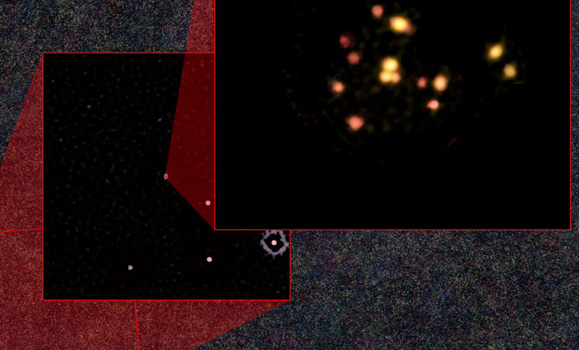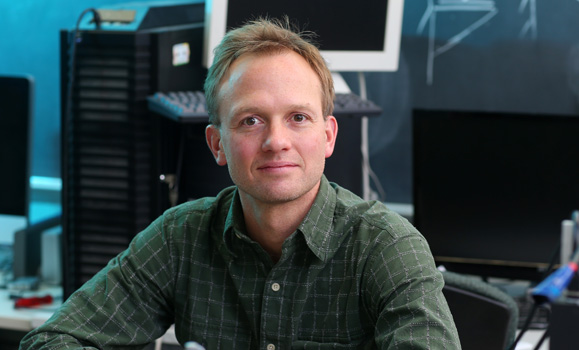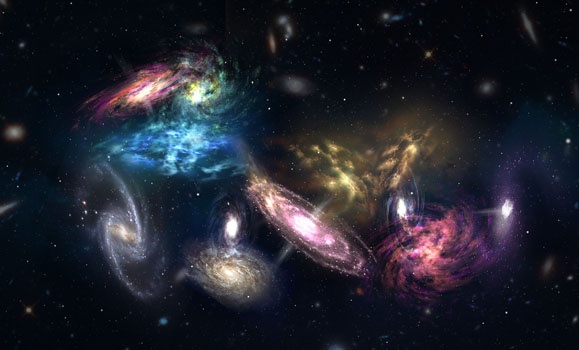What first looks like a smudge of light in a grainy telescopic image of space is actually an astronomic discovery like no other yet.
An international team of researchers led by –¬º”∆¬¡˘∫œ≤ ø™Ω±÷±≤•‚Äôs Scott Chapman and former master‚Äôs student Tim Miller looked back in time to the edge of our observable universe and found the first evidence of 14 large, dense galaxies 12.4 billion light years away from Earth‚Äîsome of the first ever formed after the Big Bang.
Located in a small area of space relative to their sizes, and the rate at which they're churning out new stars, these galaxies are merging into a protocluster ‚Äî¬Ýa grouping of galaxies in close proximity to one another. But this protocluster, by today‚Äôs calculations, is to be one of the largest galactic structures in the known universe.
Alas, scientists in our lifetime will never actually see the outcome of this merger through a telescope since it takes billions of years for this protocluster’s light to reach Earth.

Zooming in to the galaxies discovered by ALMA that are evolving into a galaxy cluster. The outer field is from data taken by the Hershel Space Observatory. The middle image -- a portion of a much-wider survey by NSF's South Pole Telescope -- uncovered the distant galactic source that was studied by ALMA to reveal the 14 galaxies. (NRAO photo)
The study, sent shockwaves through the astrophysics community. But it wasn’t necessarily because of the discovery that 14 galaxies are occupying a space that’s only three times larger than our own Milky Way, or that the galaxies are growing faster than anything in this galaxy. No, it’s because the image that led to this discovery is technically 12.4 billions of years old. That means this mass of galaxies grew to its astonishing size only 1.4 billion years after the Big Bang. A growth spurt like that doesn’t align with current scientific understanding.
Shifting the science
“Having caught a massive galaxy cluster in throes of formation is spectacular in and of itself,” Dr. Chapman, a professor of physics, . “But, the fact that this is happening so early in the history of the universe poses a formidable challenge to our present-day understanding of the way structures form in the universe.”
Current theory and computer models suggest that protoclusters as massive as the one observed by NRAO’s ALMA — the complex in Chile — should have taken much longer to evolve.
‚ÄúHow this assembly of galaxies got so big so fast is a bit of a mystery, it wasn‚Äôt built up gradually over billions of years, as astronomers might expect,‚Äù says Tim Miller (MSc‚Äô17), a coauthor who worked on the study while attending –¬º”∆¬¡˘∫œ≤ ø™Ω±÷±≤•. Miller is now a PhD candidate at Yale University. ‚ÄúThis discovery provides an incredible opportunity to study how galaxy clusters and their massive galaxies came together in these extreme environments.‚Äù
A mass of galaxies
This cluster’s extreme distance and clearly defined components offer astronomers an unprecedented opportunity to study some of the first steps of cluster formation less than 1.5 billion years after the Big Bang. By using NRAO’s ALMA data as the starting conditions for sophisticated computer simulations, the researchers were able to demonstrate how this current collection of galaxies will likely grow and evolve over billions of years.

Scott Chapman. (Nick Pearce photo)
“ALMA gave us, for the first time, a clear starting point to predict the evolution of a galaxy cluster. Over time, the 14 galaxies we observed will stop forming stars and will collide and coalesce into a single gigantic galaxy,” says Dr. Chapman.
Other study partners include the National Research Council of Canada, National Radio Astronomy Observatory, the University of Victoria (UVic), the University of Illinois and the Flatiron Institute.

